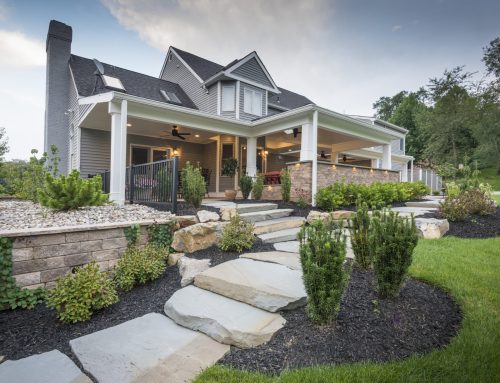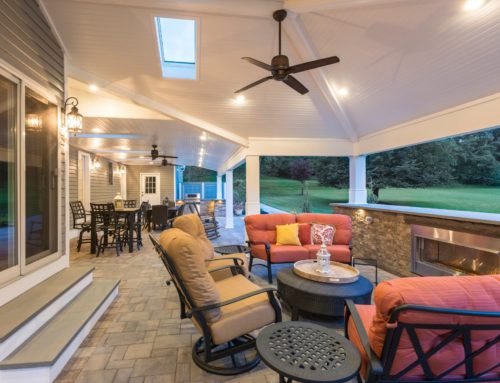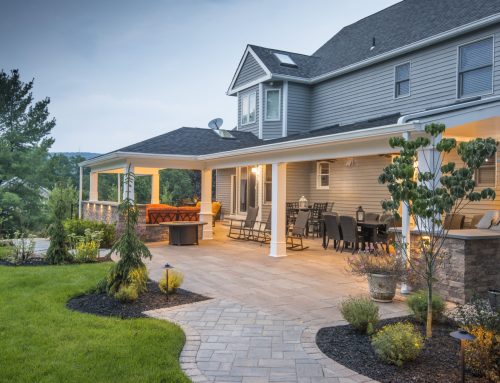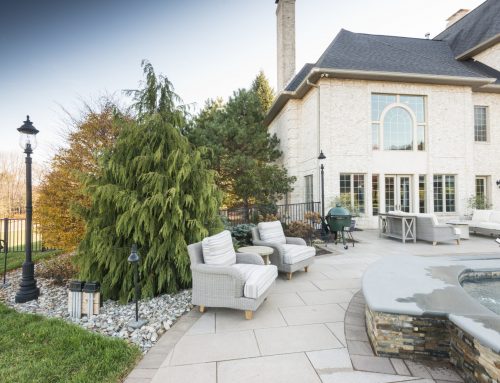If something seems too good to be true, it probably is.
Sure, it might save you a few dollars or hours now, but it’ll ultimately leave you with a headache in addition to all of the bills you were trying to avoid—and then some. When you’re looking to save time, don’t make the mistake of taking these three landscaping shortcuts below.
DIY Terrace Walls
You have a long weekend in front of you, the pizza place on speed dial, and a nephew hoping to score an easy $20 for his labor. Now is the time to bust out that DIY terrace wall, right?
Not so fast. There’s more to terrace walls than what’s on the surface—literally. Surely you’ve seen homes, maybe in your own neighborhood, that have drooping and uneven walls framing their flowerbeds. You’ve probably wondered if they even bothered to use a level. That wall didn’t start out drooping and uneven, however—it ended up that way because the homeowner took a shortcut that they probably didn’t even know they were taking.
When walls fail, most of the failures are forensically attributed to improper soil compaction. What does that mean? The soil sitting directly as well as deep underneath the terrace wall has more air space than is ideal for construction. When it’s seasonally wet, the air is displaced by water and expands before settling and drying out. This underground movement causes the terrace wall to shift and send your careful stacking sliding south.
Don’t waste your time or materials on a wall that’s doomed to fail. A landscape contractor will assess your property and utilize the necessary equipment to make sure you have a foundation that will support your wall.
Quick and Easy Wiring
Whether for aesthetics or safety, eventually, the idea of adding lighting to your property will most likely come up in conversation. Lampposts are a popular choice because they not only satisfy both aesthetics and safety due to the light they emit, but the lamppost itself can be a design feature that adds character to your yard.
Of course, a lamppost that far away from the structure of your home is going to have to obtain access to electricity somehow. A common solution is to utilize direct-buried cable, or DBC. This method uses cable with tolerances to heat, moisture, conductivity, and soil acidity, plopping it directly in the dirt. After digging a shallow trench, you flip the “on” switch and call it a successful day.
Here’s the problem: Pennsylvania’s climate has multiple freeze-thaw cycles between October and April. Our frost depth runs between 32 to 42 inches deep—right into the path of the buried wire. Over time, the moisture in the ground expands and creeps up towards the surface enough times that it brings the buried water right up to the top with it.
At first, it’s not a big deal, but then one day your landscaper is edging a bed and cuts the wire. He doesn’t even know he cut it, but later, you notice your light no longer works. You change the bulb and change the switch to no avail, eventually accepting that the light just doesn’t work anymore. It effectively becomes a sculpture in your lawn, and you lose your light.
What’s the solution? Put your wire inside of a conduit, a plastic pipe designated for electrical wire. Not only does frost have far less action on the conduit, but if ever there was a wire failure, you could pull new wire through without digging another trench.
Cutting Your Grass Too Short
When you know you’re going away next weekend or it’s going to be a busy week at work, it can be tempting to adjust your mower blades to take a bit more off. After all, if your grass is shorter, that means you’ll have more time until it gets to the length where it needs to be cut again, doesn’t it?
It makes sense on paper, but not in practice. When your grass is cut too short, you leave it more susceptible to heat damage, drought, and even weed invasion. You’re much better off hiring a landscaping service to take care of your green carpet in your absence, or even trading mowing duties with a neighbor.






